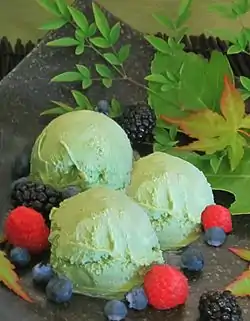Green tea ice cream
Green tea ice cream (抹茶アイスクリーム, Matcha aisu kurīmu) or matcha ice (抹茶アイス Matcha aisu) is a Japanese ice cream flavor. This flavor is extremely popular in Japan and other parts of East Asia. Green tea ice cream is also sold in monaka form. It has been available in the United States since the late 1970s, primarily in Japanese restaurants and markets, but is currently moving into mainstream availability.[1]
 | |
| Alternative names | Matcha ice |
|---|---|
| Type | Ice cream |
| Place of origin | Japan |
| Serving temperature | Cold |
Summary
There is a clear indication that Mount Fuji-shaped green tea ice cream was an item on the menu at the royal dinner party during the Meiji period (1868–1912). The true origin of green tea ice cream, however, is unknown. Although green tea itself seems to have existed as local handmade ice cream at some districts in Japan, none of the Japanese flavored ice creams were really merchandised until the 1990s because the major Japanese ice cream manufacturers were producing vanilla, strawberry and chocolate as their primary flavors. However, green tea shaved ice Uji Kintoki (宇治金時) has been well known and popular in Japan long before green tea ice cream.
The amount of imported ice cream increased in the Japanese market after the import liberalization act of ice cream in 1990.[2] Sales of Green Tea Ice Cream in Japan began with the importation of green tea ice cream from Maeda-en USA in California with the catch phrase "Pure Japanese style made from California". It has been produced since April 1995, using fresh California milk made in U.S.A. The same product was soon imported and distributed to convenience stores and supermarkets in Japan as well and it was introduced in some Japanese newspapers.[3]
During a certain period of the 1980s in Japan, Meiji Dairies started selling its green tea ice cream with Lady Borden Brand but eventually discontinued selling the product.
Häagen-Dazs Japan started producing green tea ice cream in 1996. The product is now sold in Japanese grocery markets and has become one of the company's most popular flavors.[4]
Statistics from the Japanese Ice Cream Association show that green tea ice cream was ranked third in the "Favorite Ice Cream Flavor" study.[5]
In order to prevent a change in color to green tea ice cream (catechin) from sunlight, some containers have lids with an opaque underside. Some green tea ice cream is artificially colored, and others have natural green coloring from the catechin present in green tea.
Popularity
Green tea ice cream has been available in the United States, the country with the largest ice cream consumption, since the late 1970s, primarily in Japanese restaurants and markets. It is currently becoming mainstream and can also be made at home.[6]
The U.S. saw rapid growth in Japanese cuisine and sushi popularity in the mid 1990s, which resulted in a big expansion of the Japanese restaurant business in the U.S. This development gradually helped people learn about green tea, resulting in green tea ice cream becoming a typical dessert.
With other dishes
Green tea ice cream could easily be integrated into various decorations and arrangements with other ice cream flavors. It could be served with other Japanese sweets such as Azuki (小豆), Dango (団子), and Monaka (モナカ).
 Azuki and Green Tea Ice Cream
Azuki and Green Tea Ice Cream Green Tea Mochi Ice Cream
Green Tea Mochi Ice Cream Green Tea shaved ice
Green Tea shaved ice
References
- AMANDA HESSER (1998-10-28). "Temptation; For Purists, Green Tea Ice Cream With an Asian Aura". The New York Times.
- Norinchukin Institute Co., Ltd. "Japanese Dairy Farming and the WTO Agricultural Negotiation" (PDF).
- Nihon Keizai Shimbun. 1995-04-18. Missing or empty
|title=(help) - A Taste Of Japanese Culture: The Story Of Häagen-Dazs GREEN TEA (in English)
- 日本アイスクリーム白書2016 (日本アイスクリーム協会)
- "Matcha green tea ice cream recipe". about.com. Retrieved 29 August 2010.
External links
![]() Media related to Green tea ice cream at Wikimedia Commons
Media related to Green tea ice cream at Wikimedia Commons